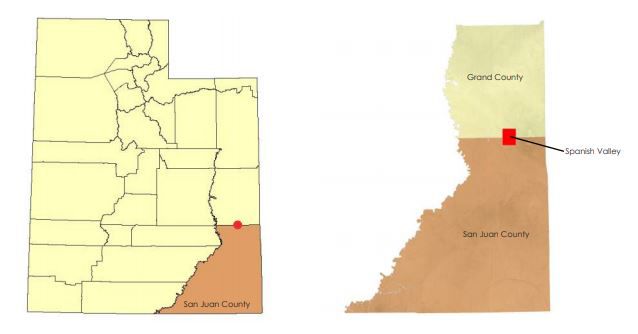Concern over the future of Spanish Valley is front-and-center for residents of northern San Juan County. Political boundaries complicate an already fraught debate over what the future of the area will look like, and how it will be decided. Three recent developments will influence decision-making in the coming years.
Closed meetings for collaboration
An attempt to formalize collaboration among San Juan County, Grand County, and Moab City with a “Spanish Valley Working Group” died recently after the entities agreed instead on informal collaboration.
A resolution proposed by Grand County Commissioner Kevin Walker in a Feb. 8 joint meeting of the three entities would have brought three representatives from each together in a “Working Group” to “assist in information sharing among the separate governing bodies.” “Working Group” was chosen as the title with the intent to be less formal than a committee.
Walker clarified in the meeting that “Spanish Valley,” in this case, refers to Moab City, unincorporated areas in Grand County south of the city, and unincorporated areas in San Juan County south of the county line. The area in total stretches from the Arches National Park entrance south to Blue Hill.
“It’s kind of a natural unit, but because of historical accident, you’ve got three different legislative bodies making planning and zoning rules,” Walker said in an interview.
A draft of the resolution was written by former attorney Liz Thomas, but Walker said the working group was his idea originally and came after a year of discussions with Moab City Council members and San Juan County Commissioners.
The resolution was approved by the Grand County Commission in that meeting. Moab City representatives at the meeting discussed Feb. 22 as the next feasible date to vote on it.
A poor phone connection prevented official approval of the resolution by the San Juan County Commissioners: After around 20 minutes of trying, Commissioner Grayeyes’s second to Commissioner Maryboy’s motion to approve the resolution could be heard, but his comments afterward were garbled so the exchange did not constitute an official approval.
Since that meeting, the resolution has not surfaced on either the San Juan County or Moab City agendas.
“The resolution that Liz Thomas drafted for Grand and San Juan County had several County Attorney concerns,” Mack McDonald, Chief Administrative Officer of San Juan County, wrote in an email.
The entities agreed a few weeks ago to meet without creating a formal working group, according to Moab Mayor Joette Langianese.
The meetings will be as needed, with the first happening in a few weeks, according to McDonald. “All of the meetings will be virtual but will not have minutes or a need to provide public notices, it is just a simple coordination meeting and nothing binding,” he said.
Water Utility Resource Management Plan Coalition
In late January, Moab City, San Juan County, Grand County, the Grand Water & Sewer Service Agency (GWSSA), the San Juan Spanish Valley Special Service District, and the Moab Irrigation Company formed the Water Utility Resource Management Plan Coalition. The coalition was recommended by the Spanish Valley Regional Water Management Coordination Group last summer.
The scope of work for the plan says that it “will assist these agencies in implementing policies intended to ensure resilient water resource management for residents, visitors, and businesses for the next 100 years.”
“We have discussed the idea of expanding GWSSA’s secondary water system which uses untreated water for outdoor use,” Dana Van Horn, agency manager of GWSSA, wrote in an email. “We could possibly build off of the existing pipes and provide service to more customers in the city or San Juan. The plan will look at the feasibility of these types of collaborative projects.”
Moab, Grand County, and San Juan County will pay 57.9%, 39.6%, and 2.5%, respectively, to the engineering firm Hansen, Allen & Luce, Inc. (HAL) to complete the plan over the next year. Those numbers are based on five-year average culinary water usage. $230,000 is budgeted for the project.
HAL has a history with Moab and San Juan County. They produced Moab’s Culinary Water Master Plans and the Stormwater Master Plan, Moab City Engineer Chuck Williams wrote in an email. San Juan County also contracted with them for a flood study in Spanish Valley a few years ago, according to McDonald.
Potential solution items on HAL’s proposal spreadsheet include groundwater development, cooperative use, conservation, and treatment of the Colorado River. Public open houses, a social media campaign, and a comment period are also built into the plan.
The plan will be complete by late 2022 or early 2023.
SJC Planning Commission
The San Juan County Planning Commission has the most direct and immediate effect on development decisions of the regulatory developments in this article. They have the power to interpret the law, and they use it regularly when making decisions on conditional use permits and building permits.
Any appeals of Planning Commission decisions, however, go through the County Commission. Appeals can be made by permit applicants, county officials, or any person affected by a Planning Commission decision.
Any legislative actions, including map adjustments, also go through the County Commission, though the Planning Commission can make recommendations.
That includes the Utah School and Institutional Trust Lands Administration’s 1,864-acre Planned Community Zone Plan application for the “South Valley Community,” approved by the County Commission after a recommendation from the Planning Commission in Dec. 2021. That approval was the first of five steps required before SITLA can break ground in the northern San Juan County area, per the San Juan County Spanish Valley Zoning Ordinance adopted in 2019.
One other step in the process, the development agreement, requires County Commission approval; the rest are handled by the Planning Commission or county staff.
If SITLA does not get a development agreement approved within 10 years from the approval of the Zone Plan, the process restarts.
During a March 15 meeting, the County Commission approved amendments to the Planning Commission bylaws, which are advisory guidelines, after hearing several public comments urging for the bylaws to be tabled.
The changes included clarifying that current Planning Commission members who want to serve another term are considered by the same process as new applicants, and moving all candidate qualifications beyond being a resident and registered voter from “Required Conditions” to “Preferred Qualifications.”
“Sometimes expertise can narrow a person’s perspective, not broaden it,” northern San Juan County resident Holly Sloan said in the meeting.
Sloan later said in an interview that she was concerned that qualified candidates weren’t interviewed. “My issue was with the process. But I’m also concerned that we’re just putting too much emphasis on the role of ‘planning expertise,’ whatever that means,” she said.
The County Commission approved the reappointments of Trent Shaffer (Monticello) and Lloyd Wilson (Special Service District), and Edward Dobson was approved to represent Bluff. Developer Shik Han’s appointment to represent Spanish Valley was not approved, however. A representative for Spanish Valley has yet to be appointed. Han did not respond to requests for comment.




